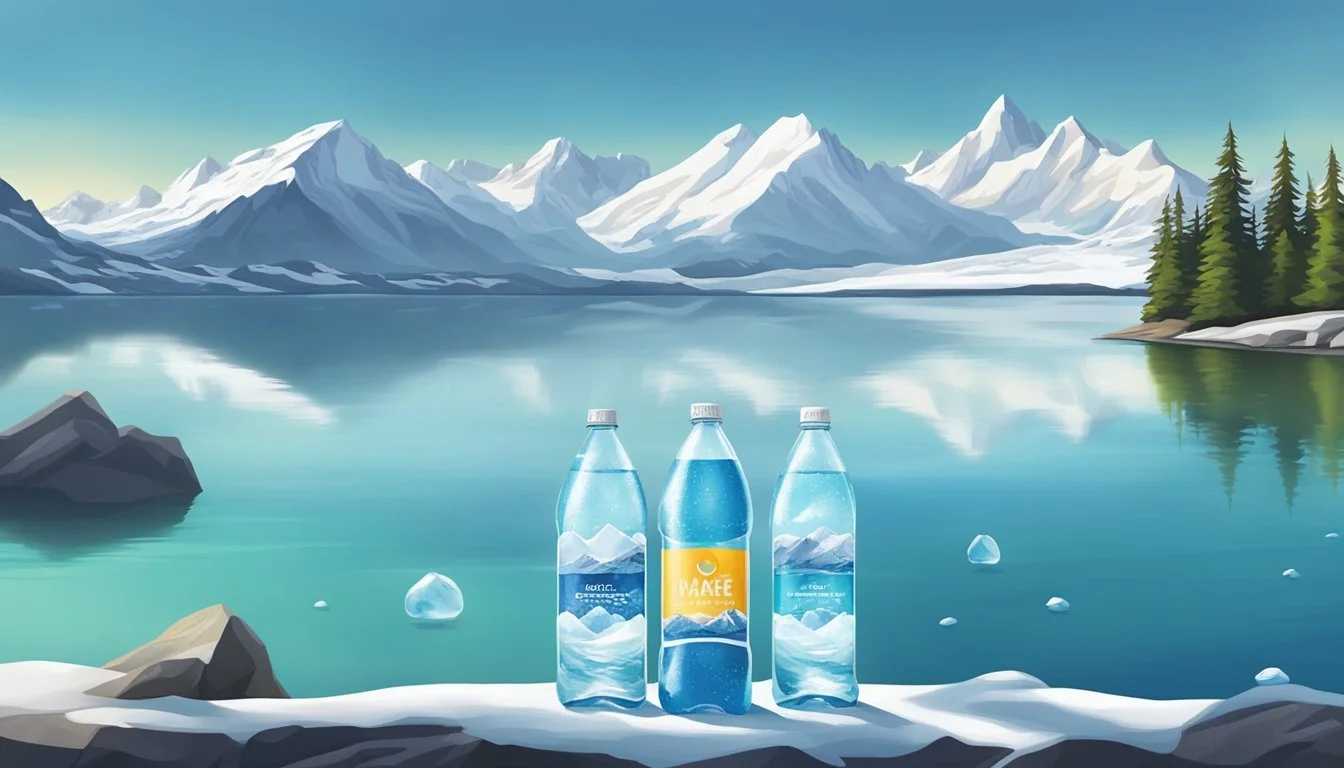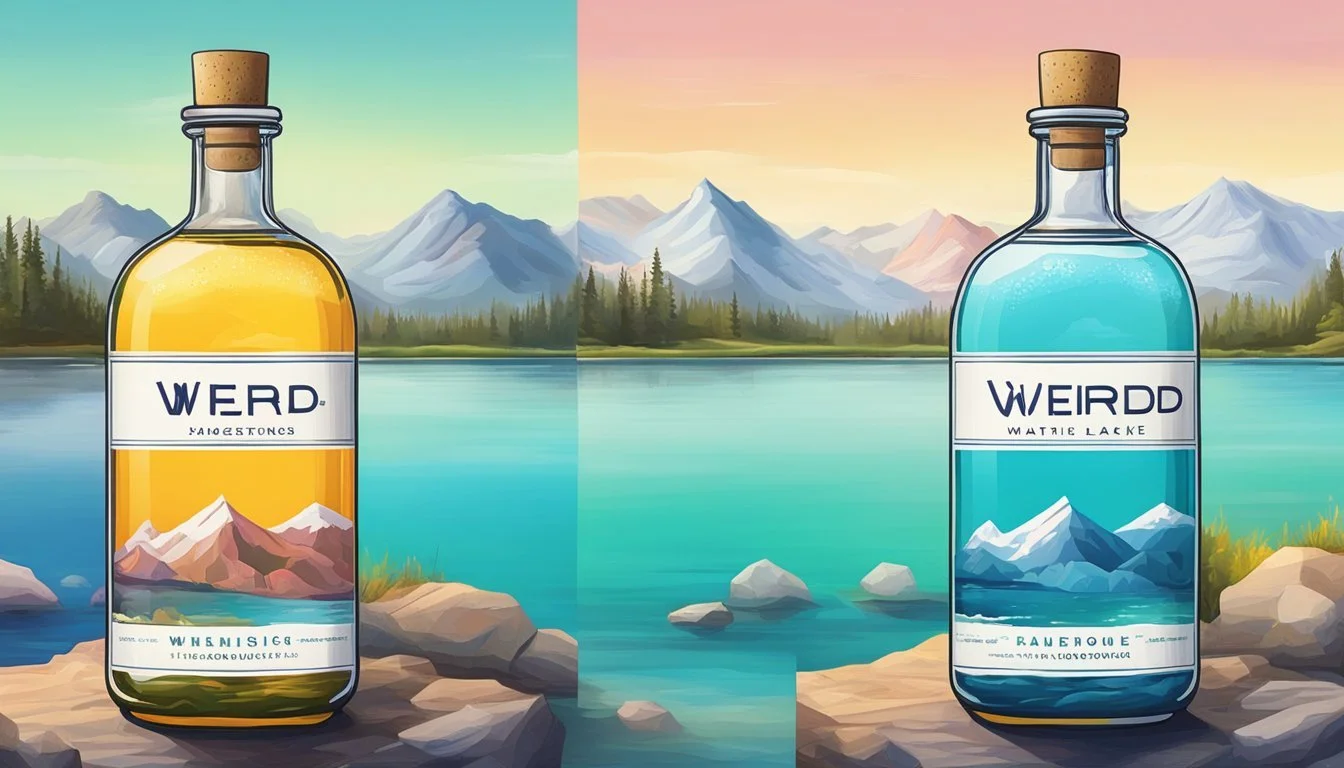Tahoe vs. Weird Water
Which Bottled Water is Better for You?
Choosing the right bottled water can be surprisingly challenging given the many options available on the market. Among these, Tahoe and Weird Water are often compared. Tahoe is frequently celebrated for its crisp and clean taste, which appeals to those who prioritize a refreshing, pure drinking experience.
Weird Water, on the other hand, sets itself apart with unique branding and a distinct flavor profile that intrigues curious consumers looking to try something new. Tahoe generally stands out for its crisper and cleaner taste, making it a preferred choice for many.
In this analysis, we'll dissect the qualities that make each brand unique, exploring their taste, mineral content, and sources to help you decide which bottled water better suits your needs. Whether you're an adventurer needing reliable hydration or simply searching for the smoothest, most refreshing option, this breakdown will provide clarity.
Evaluating Water Quality and Purity
When comparing Tahoe and Weird Water, it is essential to consider aspects such as purity standards, mineral content, and pH levels to determine which bottled water offers better quality and health benefits.
Determining Water Purity Standards
Both the FDA and the EPA set regulations to ensure the safety and quality of bottled water. The FDA oversees bottled water, enforcing standards that largely mirror those set by the EPA for tap water. Premium brands like Tahoe and Weird Water must comply with these standards.
Tahoe sources its water from natural springs, undergoing extensive purification processes to ensure contaminant levels remain well below regulatory limits.
Weird Water also adheres to strict standards, implementing advanced filtration to remove impurities. It's crucial for consumers to review the water quality reports of each brand, which detail the exact levels of various contaminants.
Assessing Mineral Content and Health Benefits
Mineral content in bottled water can affect taste and health benefits. Essential minerals like calcium, magnesium, and potassium are often present.
Tahoe claims higher mineral content, particularly in calcium and magnesium, which can contribute to cardiovascular health and bone strength.
Weird Water, on the other hand, emphasizes a balanced blend of minerals designed to promote overall hydration and well-being. This brand's focus is on providing a balanced mineral profile without any excessive elements that could negatively impact health. Reviewing the nutritional labels and conducting independent tests, if possible, helps ensure informed decisions.
Understanding PH Levels in Bottled Water
pH levels indicate acidity or alkalinity, with neutral pH being around 7. Many prefer slightly alkaline water for its proposed health benefits.
Tahoe maintains a naturally alkaline pH, typically ranging between 7.5 to 8.5. This alkalinity might assist in neutralizing excess acid in the body and improving hydration.
Weird Water often manages a stable pH level through natural filtration processes, usually around 7. Consumers should think about their personal health needs and how the pH of the water aligns with those requirements.
Investigating these variables enables a thorough comparison between Tahoe and Weird Water, guiding consumers to the choice that best fits their health and hydration needs.
Sourcing and Origin
Both Tahoe and Weird Water offer unique sourcing methods that highlight their distinct appeal. Tahoe prides itself on its natural spring sources, while Weird Water emphasizes sustainable practices.
The Significance of Natural Springs
Tahoe sources its water from the Lake Tahoe area, tapping into the natural spring water that flows through the region. This method ensures minimal processing, preserving the water’s natural mineral composition.
Natural spring water is often considered superior because it is filtered through earth layers, providing a unique taste and higher purity. Consumers seeking crisp, refreshing water often prefer brands that utilize such pristine sources.
Weird Water, while not explicitly mentioned for spring sources, underscores its commitment to environmental sustainability. Although their main focus is on eco-friendly packaging, sourcing quality water also plays a significant role.
Aquifers and Groundwater
Aquifers and groundwater systems are vital for both brands. Tahoe's water, emerging from natural springs, originates from mountain aquifers that store and filter the water through geological processes. This natural filtration helps maintain the purity and quality that Tahoe boasts.
Weird Water may use similar aquifer systems, although their emphasis is more on the sustainable management of water resources. Groundwater management ensures that their brand maintains both environmental integrity and water quality.
Aquifers act as underground reservoirs, and effective use of these resources is crucial. Both brands likely ensure responsible extraction practices, preserving the ecosystems that support their water sources.
Taste Profiles of Bottled Waters
Tahoe and Weird Water are distinct in their taste profiles, offering different experiences to consumers. This section compares these two brands and examines how they stand among other popular bottled waters through various taste tests.
Comparing Taste: Tahoe vs. Weird Water
Tahoe is characterized by its neutral taste, appealing to those who prefer water with minimal flavor. This quality makes it a favored choice for people who want a clean and straightforward hydration experience.
Weird Water, on the other hand, provides a unique blend often described as crisp and refreshing. This profile sets it apart from other brands and captures the attention of those looking for something beyond the ordinary.
Both brands use careful sourcing and filtration methods to achieve their distinct taste profiles. Consumers tend to choose between them based on personal preference for either a neutral or a more pronounced taste.
Conducting Taste Tests with Popular Brands
Various taste tests have ranked Tahoe and Weird Water among other popular brands. For instance, in blind taste tests, preferences varied widely, highlighting the subjective nature of water taste.
Popular brands such as Arrowhead, Poland Spring, and Evian were included in these comparisons. Testers rated them based on factors like freshness, aftertaste, and overall drinkability.
Participants often noted the subtle differences between Tahoe's neutral profile and Weird Water's crisp taste. Such tests reveal that while personal preference plays a significant role, the distinctive characteristics of each brand provide clear reasons why one might be chosen over another.
Specific Water Brand Analysis
Examining the key attributes of Tahoe and Weird Water reveals distinct advantages and characteristics in the bottled water market. Other benchmark brands like Dasani, Aquafina, and Evian help contextualize the competitive landscape.
Exploring Tahoe Water: Brand Profile and Market Position
Tahoe Water sources its product from natural springs, emphasizing purity and minimal processing. The brand is known for its clean taste, reflecting the pristine quality of its sources. Tahoe aims to cater to consumers seeking transparent, ethically-sourced bottled water.
In the market, Tahoe holds a strong position among premium water brands. Competing with names like Evian and Fiji, Tahoe leverages its environmental commitment and local sourcing as key selling points. This niche appeal resonates with eco-conscious consumers.
Weird Water: Origin and Unique Selling Propositions
Weird Water differentiates itself through a unique blend, offering a crisp and refreshing taste. Originating from sustainable sources, it aims to disrupt traditional bottled water markets by introducing innovative flavors and packaging.
Weird Water’s branding focuses on appealing to a younger demographic interested in sustainability and modern aesthetics. Its market strategy includes quirky marketing campaigns and partnerships with environmental initiatives, making it popular among environmentally-aware consumers.
Benchmark Brands in the Bottled Water Industry
Brands like Dasani, Aquafina, and Smartwater dominate the bottled water market with extensive distribution networks and large-scale marketing efforts. Dasani and Aquafina, both owned by major beverage corporations, prioritize affordability and availability.
Evian and Fiji cater to the premium segment, known for their high-quality sources and distinctive mineral contents. Smartwater, recognized for its vapor-distilled process, appeals to health-conscious individuals. These benchmark brands set high standards in taste, quality, and consumer trust, making them key competitors for both Tahoe and Weird Water.
Enhancement Processes in Bottled Water
Bottled water often undergoes various enhancement processes aimed at improving quality, taste, and health benefits. Key processes include reverse osmosis, alkaline water infusion with electrolytes, and methods of distillation and disinfection.
Reverse Osmosis and Its Effect on Water
Reverse osmosis is a popular method used in bottled water production. This process forces water through semi-permeable membranes to remove contaminants, including dissolved salts, bacteria, and particulate matter.
It effectively reduces the presence of heavy metals and other pollutants, resulting in pure, clean-tasting water. However, reverse osmosis also removes beneficial minerals, which are sometimes reintroduced later.
Alkaline Water and Electrolyte Infusion
Alkaline water has a higher pH level compared to regular water. This is achieved by adding electrolytes and minerals such as potassium, magnesium, and calcium during the production process.
Consuming alkaline water can neutralize excess acidity in the body and improve hydration levels. Brands often market it as providing added health benefits, such as improved metabolism and enhanced energy.
Distillation and Disinfection Processes
Distillation involves heating water to create steam, which is then condensed back into liquid, leaving impurities behind. This method effectively removes bacteria, viruses, and other contaminants, producing high-purity water.
Disinfection is another crucial step, ensuring bottled water is free from harmful microorganisms. Disinfection methods include ozone treatment, ultraviolet (UV) radiation, and chlorination. These procedures protect against potential health risks, contributing to the safety and cleanliness of bottled water.
Bottled vs. Tap Water
When comparing bottled water to tap water, it’s essential to look at quality standards and convenience. These elements play significant roles in choosing between the two.
Quality Comparisons and EPA Standards
Bottled water and tap water in the United States adhere to different sets of regulations. Tap water is regulated by the Environmental Protection Agency (EPA), which sets strict standards for water quality.
The EPA imposes rigorous testing for contaminants and mandates public reporting. Bottled water, on the other hand, is overseen by the Food and Drug Administration (FDA). While still regulated, FDA standards can sometimes be less stringent than those of the EPA.
A notable finding is that nearly 64% of bottled water sold in the U.S. is essentially repackaged tap water. Despite assumptions that bottled water is purer or safer, this is not always true. With proper infrastructure, tap water can be a reliable and safe drinking source.
Convenience, Accessibility, and Drinking Habits
Bottled water offers unmatched convenience. It is easy to grab on the go and widely sold in numerous locations. This accessibility can support an active lifestyle, providing hydration anytime and anywhere.
Tap water, however, is much more economical. A reusable water bottle filled from a tap is far cheaper over time and environmentally friendlier. This also reduces plastic waste, which is beneficial for global sustainability.
In terms of drinking habits, many people favor the taste and perceived purity of bottled water. However, with modern filtration systems, tap water quality can be enhanced, potentially matching bottled water's taste and appeal. Consequently, choosing between bottled and tap water often comes down to situational convenience and personal preferences.
Environmental Impact and Sustainability
The production and disposal of bottled water pose significant environmental concerns, particularly around plastic usage and pollution. Eco-friendly alternatives like glass bottles and boxed water offer solutions to mitigate these issues.
Plastic Use and Waste Management
Plastic bottles are at the center of environmental debates due to their adverse impacts. Manufacturing these bottles requires substantial amounts of water, and it takes three times as much water to produce a plastic bottle as it can hold.
Plastic waste management is another critical issue. A large percentage of plastic bottles end up in landfills or oceans, where they contribute to pollution and harm wildlife. Recycling rates are relatively low, exacerbating the environmental impact.
Efforts to curb plastic use include bans on single-use plastic bottles, such as the one set to be implemented in South Lake Tahoe in 2024. Initiatives to promote reusable bottles and water refill stations are gaining traction, aiming to reduce reliance on disposable plastics.
Eco-Friendly Alternatives: Glass and Boxed Waters
Eco-friendly alternatives like glass bottles and boxed water are becoming more popular. Glass bottles, while heavier and more expensive to transport, are infinitely recyclable and do not suffer from the same environmental degradation issues as plastic.
Boxed waters, typically made from renewable resources, offer another sustainable alternative. These are often easier to produce and dispose of in an environmentally friendly manner.
The shift towards eco-friendly options is supported by companies and local businesses that install refill stations to encourage the use of reusable bottles. These alternatives represent a tangible step towards reducing the carbon footprint associated with bottled water.
Economic Perspectives on Bottled Water
Bottled water has seen continuous growth in popularity, driven by various factors including perceived convenience and taste. Analyzing price points and availability reveals key economic considerations impacting consumer choices.
Price Point Analysis Across Different Brands
The price of bottled water varies significantly between brands and types. Premium brands like Evian and Fiji often command higher prices, typically ranging from $1.50 to $3.00 per bottle. In contrast, economy brands such as Aquafina and Dasani are more affordable, generally priced between $0.50 and $1.00 per bottle.
A detailed comparison shows that premium brands market their water as sourced from exotic locations, contributing to higher costs. Meanwhile, economic brands leverage their wide distribution networks to keep prices low. Price differences also arise from packaging costs, branding, and marketing efforts. Cheaper brands frequently use lighter PET bottles to reduce manufacturing expenses.
Bottled Water Availability in Grocery and Convenience Stores
Bottled water availability is extensive across both grocery and convenience stores. Grocery stores stock a wide array, from budget options to premium brands, catering to diverse consumer preferences. It is common to find large multi-packs and various bottle sizes, giving consumers options for bulk purchasing, which can reduce per-unit costs.
Convenience stores typically offer a narrower selection emphasizing convenience and immediate consumption. Prices are often higher compared to grocery stores due to the convenience factor and smaller packaging sizes. The accessibility of bottled water at these locations underscores its role as a staple beverage, reflecting its integration into everyday consumer purchasing habits.
In both retail settings, special promotions and discounts can influence the final price, affecting consumer choice. The steady demand in both outlets ensures continuous availability, supporting the bottled water market's economic viability.
Hydration and Its Effects on Energy and Performance
Proper hydration is crucial for maintaining energy levels and enhancing performance. Bottled water, particularly brands like Tahoe and Weird Water, can play a significant role in hydration strategies tailored to individual needs.
The Role of Bottled Water in Hydration Strategies
High-quality bottled water options can vary in their mineral content and pH levels, potentially impacting hydration effectiveness. Tahoe water is known for its balanced mineral content, which may support sustained energy release during physical activities. Mineral-rich water is beneficial as it helps maintain electrolyte balance, reducing the risk of dehydration.
Conversely, Weird Water often markets its unique composition, such as added electrolytes or alkaline properties. These features can aid in quicker hydration and improved performance, particularly in high-intensity activities. Such characteristics make it a choice for athletes aiming for rapid rehydration.
The choice between these bottled waters depends on personal preferences and activity demands. Individuals looking for consistent hydration might prefer Tahoe, while those needing immediate energy boosts may opt for Weird Water.
More About Tahoe
Mountain Valley Spring Water vs Tahoe: Which Bottled Water is Better?
Tahoe vs Richard's Rainwater: Which Bottled Water is Better?
Tahoe vs Whole Foods Italian Still Mineral water: Which Bottled Water is Better?
More About Weird Water
Aqua Carpatica vs Weird Water: Which Bottled Water is Better?
Cascade Mountain vs Weird Water: Which Bottled Water is Better?
Core Hydration vs Weird Water: Which Bottled Water is Better?
Crystal Geyser vs Weird Water: Which Bottled Water is Better?
Hawaii Volcanic vs Weird Water: Which Bottled Water is Better?
Hawaiian Springs vs Weird Water: Which Bottled Water is Better?
Icelandic Glacial vs Weird Water: Which Bottled Water is Better?
Mountain Valley Spring Water vs Weird Water: Which Bottled Water is Better?
Nestle Pure Life vs Weird Water: Which Bottled Water is Better?
Poland Spring vs Weird Water: Which Bottled Water is Better?
Purely Sedona vs Weird Water: Which Bottled Water is Better?
Richard's Rainwater vs Weird Water: Which Bottled Water is Better?
San Pellegrino vs Weird Water: Which Bottled Water is Better?
Solan de Cabras vs Weird Water: Which Bottled Water is Better?
Talking Rain AQA vs Weird Water: Which Bottled Water is Better?
Weird Water vs Kirkland Signature: Which Bottled Water is Better?
Weird Water vs Whole Foods 365: Which Bottled Water is Better?
Whole Foods Italian Still Mineral water vs Weird Water: Which Bottled Water is Better?








